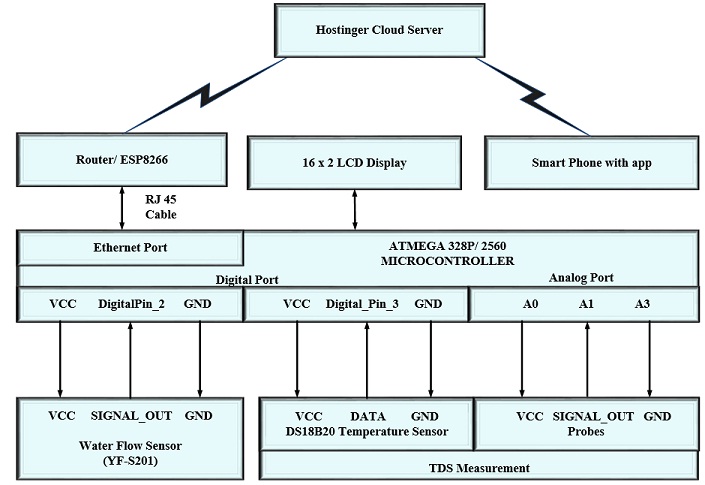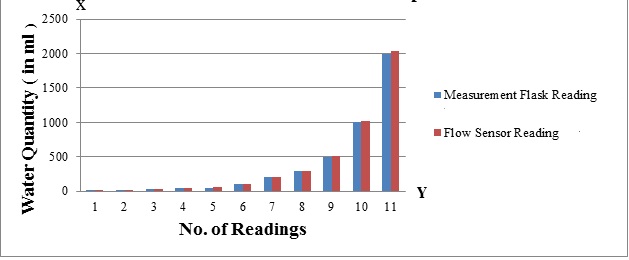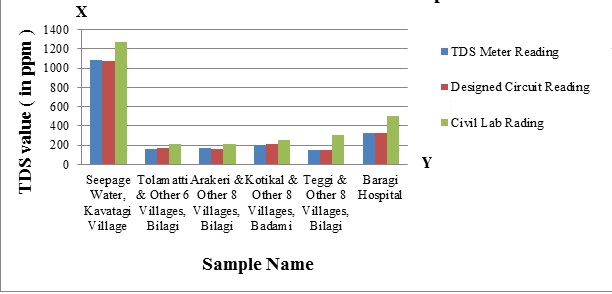





Published on Nov 30, 2023
By 2020, 20 to 30 billion devices will be connected to the internet. In future, because of IoT based technology, gadgets such as washing machine, water purifier, refrigerator, T.V, microwave oven, health care devices will be connected to the internet.TheInternetofThings(IoT)isasystemofinterrelatedcomputingdevices,mechanicaland digital machines, objects, animals or people that are provided with unique identifiers and the ability to transfer data over a network without requiring human-to-human or human-to-computer interaction. Features of current water purifier:
Double purification by RO and UV with TDS controller and TDS modulat
Six stage purification with LCD display.
Digital advanced alert system. Alerts 15 days before end life of germ kill kit.
Soft touch water dispensing: Easily dispense water with just a press of a button.
In the proposed project, hardware and software is designed and developed to make existing water purifier IoT enabled. Three sensors namely water flow sensor(YF-S201),custom designed TDS (Total Dissolved Solids) sensor along with temperature (DS18B20) sensor are interfaced to microcontroller ATMEGA328P/ATmega 2560. Water flow sensor is used to measure the flow rate of water and custom designed TDS sensor along with temperature sensor works on the principle of electrical conductivity, and used to measure the total dissolved solids in the water and to know the hardness or quality of the water. Software developed on ATmega 328P/ATmega 2560 microcontroller reads the data from these three sensors and the data is calibrated and uploaded to the cloud server (Hosting er free web server) by internet connectivity. Android app is designed, developed and uploaded on Google play store and is available for free download. User of water purifier can install the app in the smart phone and access the data of water usage and hardness of water by connecting it to Hosting er web server. The proposed project is not the continuation of any previous work as it is based on recent technology called IoT.
The next progress in the era of development will be the automatic working of the things. The things surrounding us will be connected with each other with the help of network which automation. The use of these devices would involve three main steps: capture of data using sensors, collection of data over the network an d decision making based on analysis of data. Each sensor provides valuable data which tell about the working of things. The indispensable part of IoT is smart connectivity of the things with the network. Although the definition of Things has changed as technology evolved, the goal of making computer to sense the information without the aid of human intervention remains the same. IoT is a concept to interconnect the uniquely identifiable embedded computing devices as expected to offer Human-To-Machine (H2M) communication by replacing the model of Machine-To-Machine communication which exists nowadays.
The convergence of multiple technologies had done from embedded systems to micro -electromechanical systems, and also from the wireless communication to internet. It has brought an upsurge in the development IoT technologies. IoT provides a platform for the objects to manage and organize themselves which makes them recognizable. In the future there are many application of IoT such as smart city, smart home appliances etc. Each thing is uniquely identifiable but follows a common infrastructure. It is the common IoT platform that collects diversified information together and provides common language for devices and apps to communicate. The process starts with the devices themselves which securely communicate with an IoT platform. These platforms integrate data from many devices and share the same to the industries specific need.
To provide purifier with water TDS measurement and display.
To provide day by day measure of water usage.
Alert for candle life.
The data will be uploaded to cloud server and user can know water usage by embedded display in purifier.
Manufacturer of water purifier can charge the user based on water usage instead of the amount charged for purifier.
The block diagram in Fig. 1 show inter connection of three sensors to the ATmega328P/ATmega2560 microcontroller board. The flow sensor is connected to digital pin 2 of the microcontroller. The flow sensor produces 450 pulses for every one liter of water output through it. By counting the number of pulses arriving at digital pin2, measurement of water usage can be done by multiplying the number of pulses with scaling factor 2.5 (Since one pulse is equal to 2.5 ml). To measure TDS value of water a custom designed TDS sensor and a temperature sensor are used by exploiting the principle of electrical conductivity of water, which also involves temperature compensation [4].The temperature sensor DS18B20 data terminal is connected to digital pin 3 of microcontroller from which we get temperature of water. Electrical conductivity of water is not calculated directly. To calculate electrical conductivity of water, resistivity of water is measured. This is carried out by dipping two probes in water, separated by 1cm, then applying analog voltage of 5V from analog port A3 of microcontroller and measuring voltage drop across the probes and is made available at the analog port A0. Using Ohm’s law resistance between the probes is calculated and inverse of resistance gives conductivity of water. To know hardness of water temperature compensation is done.
The data is uploaded to cloud server by wireless mode in which an ESP8266 Wi-Fi chip is used. The ESP8266 chip is connected to ATMEGA-328P/ATmega 2560 microcontroller board. The ESP8266 operates at 3.3VVCC. ESP8266 is configured to act in station mode using AT commands. The ESP8266 has in built TCP/IP stack and can be connected to mobile hotspot to grant internet access to ESP8266. The microcontroller communicates to ESP8266 using serial pins and also relies data to ESP8266 using serial communication which will be uploaded to cloud server by ESP8266.



As the proceeding part the web server can be implemented using FPGA in which a webpage is hosted by flashing flash memory of the FPGA with webpage to be served. The FPGA board can be made to work as a client and all the sensors used in this project can be interfaced with FPGA board and the data of all the sensors can be uploaded to cloud server having FPGA in client mode. Only a certain part of FPGA board can be used to implement the project implemented using microcontroller and cost comparison can be made.
Microcontroller based hardware and software is designed to make existing water purifiers IoT enabled. Designed prototype is tested and working satisfactorily. TDS value obtained from the prototype is compared with lab values obtained from environmental lab using chemical process and standard TDS meters available in the market and all the readings gave similar results. The water TDS value and usage data is successfully uploaded to cloud server Hostinger and data is available to user by android application which is to be installed in smart phone. As the proceeding part the web server is implemented using FPGA in which a web page is hosted by flashing flash memory of the FPGA with webpage to be served.
1. Gavriil Tzortzakis, Eli Katsiri, George Karavokiros, Christos Makropoulos and Alex Delis, “Tethys: Sensor based Aquatic Quality Monitoring in Water ways”, published in 2016 at 17thIEEE International Conference on Mobile Data Management.
2. Kiran S. Shingote and Prof. Priti Shahane, “Microcontroller Based Flow Control System for Canal Gates in Irrigation Canal Automation”, published at 2016 IEEE 6th International Conference on Advanced Computing.
3. R.G. Jones, “Measurements of the electrical conductivity of water”, IEE Proc.-Sci. Meus.Technol.Vol.149.No.6.Nowinher2002.
4. Masaki Hayashi“ Temperature-Electrical Conductivity relation of water for environmental monitoring and geographical data inversion”, Department of Geology and Geophysics, University of Calgary, Calgary, Alberta, Canada.